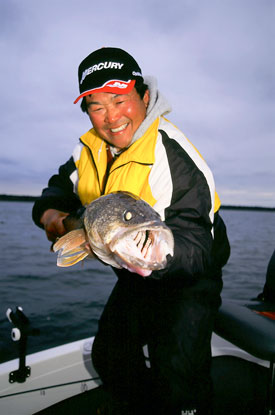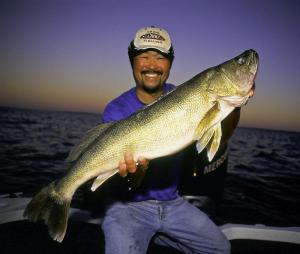Though it can get cold- make that, very cold – during the fall, you don’t need rocks in your head to chase late-season walleyes.
 Even more than spring, autumn can be the best time to hook the trophy of a lifetime. The fish are big and hungry and unlike spring when they are spawning, eating is the only thing on their minds in fall as they fatten up for winter.
Even more than spring, autumn can be the best time to hook the trophy of a lifetime. The fish are big and hungry and unlike spring when they are spawning, eating is the only thing on their minds in fall as they fatten up for winter.
Weather and water levels can also be more stable later in the season than earlier in the year.
But, whether we’re targeting rivers or lakes in fall, we certainly should have rocks on our minds. The biggest walleyes (and highest concentrations) will be schooled around places with hard bottoms. Take the time to find rocks, then locate the spot-on-the-spot and hold onto your rod. That chill in the air just might signal the hottest bite you’ve seen all year.
Rivers
Many walleye fishermen head to places like the Mississippi or the Illinois River in spring when the spawning instinct sends huge numbers of walleyes and saugers upstream. But the savviest walleye anglers know the spawning migration actually begins in fall. The fish that were scattered and hard to find all summer begin schooling and traveling toward hard-bottom spots where they’ll spawn when the combination of temperature, daylight and current is right, come springtime.
Conditions can be better in October through December than they are in March and April, too. Rivers are the most consistent where you’re not dealing with erratic water levels and floods.
You’re also not dealing with the crowds you see earlier in the year. By this time, many anglers have set aside fishing rods and picked up their guns or bows to hunt deer. If they head to the water, it’s only to down geese or ducks.
River bends, where current strength lessens and offers fish places to rest, are key. But where inside bends were best in spring, outside bends may hold fish in fall. Check for places where moving water and barge propellers have gouged big, deep holes, especially near hard bottom areas that feature gravel and clam shells. Fish will be looking for ways to escape moving water where they must burn precious energy just to stay in place.
Hard-bottom areas at the mouths of backwaters are also key spots. As colder nights lower the water temperature and kill vegetation in the shallows, baitfish move toward the main river. Predators station themselves at the openings and make a killing – literally. The mouths of creeks offer the same scenario.
Keep it simple. Slip jig downstream with a Fuzz-E-Grub jig just heavy enough to maintain bottom contact. Lindy’s new X-Change jigheads allow you to change the weight to match the depth, current and other factors like wind. They also let you change up colors to see if walleyes and sauger show a preference, and they often do. Use braided line to increase sensitivity, so you can feel transition areas from mud to rocks. Turn up the gain on your sonar. When you see a double bottom (‘second echo’) appear on the screen, you know the bottom is hard.
Pull three-way rigs upstream as an alternative. Use a Lindy NO-SNAGG sinker with a dropper and enough weight to keep the line at a 45-degree angle while slowly moving upstream or hovering with your bow-mounted trolling motor. Use a floating shallow diving crankbait or plain hook tipped with a lively minnow. Add color with a bead or a floating jig.
In rivers like the Mississippi, fish will also station themselves on wingdams near the backwaters.
Experience tells us not all wingdams are alike. Often, the ones positioned near bends hold the most fish. Usually, if the first dam and the last dam in a series don’t hold walleyes, move on. Look for wingdams where current has blown holes through the face. These holes are often the spot on the spot.
Try anchoring upstream from the face of the wingdam and cast light jigs on 10-pound line. The combination of a light jig and heavy line creates a bow in the line that will allow you to work the jig up to the face of the dam where the current flow creates an area of slack water. The slack water allows feeding walleyes to ambush forage while not having to expend a lot of energy to stay put. Use a 7-foot rod with a light-action tip. Watch your line carefully, as you often won’t even feel the hit.
The main dams halt forward progress of the fall walleye migration. Don’t overlook eddies located on each side or the deep holes just downstream. Check state laws to be certain fishing near dams is legal. Some states have placed the area off limits because so many fish stack there, catching is easy, but the water is so deep, releasing fish unharmed is not.
Another tip: look for neckdown areas with rocks. They will often produce killer night bites, whether you target a river or lake. Check them during daylight, too.
Lakes
 Shoreline points and islands that feature fast drops to deep water are key spots on lakes. Walleyes in areas like that can hold in deeper water for security and swim to shallower water to feed without much effort. Use Lindy Rigs with big chubs and NO-SNAGG sinkers to move up and down the dropoffs. Keep your bait fresh and tail hook it so it struggles to attract nearby walleyes. Try using 10-pound braided line, like Power Pro, for your main line, with a fluorocarbon leader on a rod rated for 8- to 14-pound-test line. The rod must have enough backbone for good hooksets in deep water but have a limber enough tip to vibrate when the forage reacts to an approaching walleye. Be ready when the chub starts to struggle… a walleye is close by.
Shoreline points and islands that feature fast drops to deep water are key spots on lakes. Walleyes in areas like that can hold in deeper water for security and swim to shallower water to feed without much effort. Use Lindy Rigs with big chubs and NO-SNAGG sinkers to move up and down the dropoffs. Keep your bait fresh and tail hook it so it struggles to attract nearby walleyes. Try using 10-pound braided line, like Power Pro, for your main line, with a fluorocarbon leader on a rod rated for 8- to 14-pound-test line. The rod must have enough backbone for good hooksets in deep water but have a limber enough tip to vibrate when the forage reacts to an approaching walleye. Be ready when the chub starts to struggle… a walleye is close by.
A soft tip also lets the rod absorb the shock of a big fish, a must when using no-stretch braided line.
Don’t overlook rock piles. But, it’s important to realize the impact of turnover on fish location. Lakes stratify in summer with walleyes and other fish trapped in the water above the thermocline when oxygen content below it drops too low to support life. But that changes when water temperature drops down into the low 50s F. Water becomes heavier at that point and the water on top sinks and allows oxygen to mix at all depths again. Fish are free to travel downward as water near the surface dips below their comfort zones.
As a result, rock piles at ever-increasing depths start to hold walleyes. If you aren’t catching fish on rock piles that held walleyes in the warm months, go deeper.
It’s not all about hard bottoms in autumn. Walleyes will converge on mud flats if an insect hatch occurs. But at the same time, turn up the gain on the sonar and watch for places where a double bottom appears, signaling a transition to harder bottom. Travel around the area slowly. You might stumble across a peak (slightly higher point) in the rocks, where walleyes are gathered as if they were invited to Thanksgiving dinner.
Just because it’s cold and deer season is open doesn’t mean that fishing in autumn requires rocks in your head. But, you sure should have rocks on your mind.










